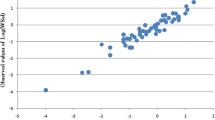Abstract
A systematic study has been carried out on the solvent and concentration dependence of the P=O stretching vibrationv(PO) of the model compoundEt 3PO in various aprotic and several CH-acidic solvents. Evidence has been found for the existence of dipole-dipole complexes in concentrated solutions ofEt 3PO in solvents of low acceptor numbers. In dilute solutions, however, the P=O stretching band generally occurs as a single symmetrical peak which shows that only one kind of solvate species is present in solution. In CH-acidic solventsEt 3PO is present in the form of hydrogen bonded complexes. Informations about the structure of these complexes have been obtained by means of spectrophotometric titrations. It has been shown that the wavenumbersv°(PO) obtained by extrapolation ofv(PO) values to zero concentration are linearly related to the acceptor numbers of the solvents, previously derived from31P-chemical shift measurements. The existence of this linear relationships proves that both parameters are linearly related to the strength of the intermolecular interactions and are virtually free from unspecific contributions such as magnetic anisotropy or vibrational coupling effects. The results of the present study show that the P=O stretching vibration ofEt 3PO represents an ideal probe for the investigation of solvent effects and solvation mechanisms.
Zusammenfassung
Es wurde die Konzentrations- und Lösungsmittelabhängigkeit der P=O-Valenzschwingungv(PO) der ModellverbindungEt 3PO in verschiedenen aprotischen und CH-aciden Lösungsmitteln systematisch untersucht. In hinreichend verdünnten Lösungen tritt die P=O-Valenzschwingung als einzelne symmetrische Bande auf, was beweist, daß nur eine einzige Solvatform vorliegt. In Lösungsmitteln niedriger Akzeptorzahl konnte bei höheren Konzentrationen die Existenz von Dipol-Dipol-Komplexen nachgewiesen werden. In CH-aciden Lösungsmitteln liegtEt 3PO in Form von Wasserstoffbrückenkomplexen vor. Aussagen über die Struktur dieser Komplexe konnten mit Hilfe spektrophotometrischer Titrationen erhalten werden. Die durch Extrapolation auf Konzentration null erhaltenen Wellenzahlenv° (PO) hängen linear von den aus den31P-chemischen Verschiebungen vonEt 3PO bereits früher bestimmten Akzeptorzahlen der Lösungsmittel ab. Die Existenz dieser linearen Beziehung beweist, daß beide Parameter frei von störenden Einflußfaktoren (magnetische Anisotropie- und Schwingungskopp-lungseffekte) sind und tatsächlich linear mit der Stärke der intermolekularen Wechselwirkung variieren. Die Ergebnisse der vorliegenden Studie zeigen, daß die P=O-Valenzschwingung vonEt 3PO eine hervorragende Sonde zur Untersuchung von Lösungsmitteleffekten und Solvatationsmechanismen darstellt.
Similar content being viewed by others
References
Leffler JE, Grunwald E (1963) Rates and Equilibria of Organic Reactions. Wiley, New York
Amis ES, Hinton JF (1973) Solvent Effects on Chemical Phenomena. Academic Press, New York, London
Mayer U (1975) Pure Appl Chem 41: 291
Mayer U (1978) Monatsh Chem 109: 421
Mayer U (1978) Monatsh Chem 109: 775
Koppel IA, Palm VA (1972) In:Chapman NB, Shorter J (eds) Advances in linear free energy relationships. Plenum Press, London, New York
Reichardt C (1979) Solvent effects in organic chemistry. Verlag Chemie, Weinheim, New York
Mayer U (1979) Pure Appl Chem 51: 1697
Mayer U (1983) Studies in physical and theoretical chemistry, vol 27: Ions and molecules in solution. Elsevier, Amsterdam, p 219
Mayer U, Gutmann V, Gerger W (1975) Monatsh Chem 106: 1235
Mayer U, Hoffmann H, Kellner R (1988) Monatsh Chem 119: 1223
Riddick JA, Bunger WB (1970) In:Weissberger A (ed) Techniques of Chemistry, vol II, Wiley-Interscience, New York, Toronto
Bauer G,Mayer U et al (to be published)
Hoffmann H Thesis PD, Technical University of Vienna
Goubeau J, Lentz A (1971) Spectrochim Acta 27A: 1703
Mayer U,Danzinger F, unpublished results
Rauchbüchl A Thesis PD, Technical University of Vienna
Mayer U,Danzinger F (to be published)
Mayer U,Schneider B (to be published)
Author information
Authors and Affiliations
Rights and permissions
About this article
Cite this article
Mayer, U., Hoffmann, H. & Kellner, R. IR-spectroscopic investigations on solute-solvent interactions Part 1: Solvation of triethylphosphine oxide in aprotic and CH-acidic solvents. Monatsh Chem 119, 1207–1221 (1988). https://doi.org/10.1007/BF00808302
Received:
Accepted:
Issue Date:
DOI: https://doi.org/10.1007/BF00808302




